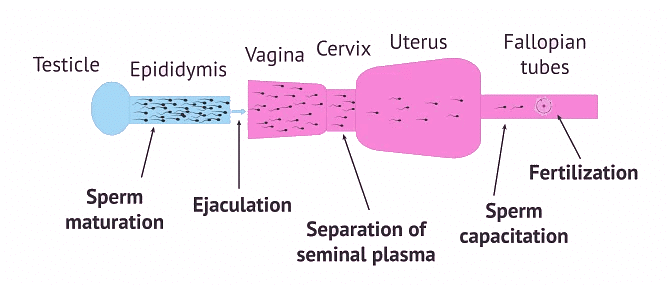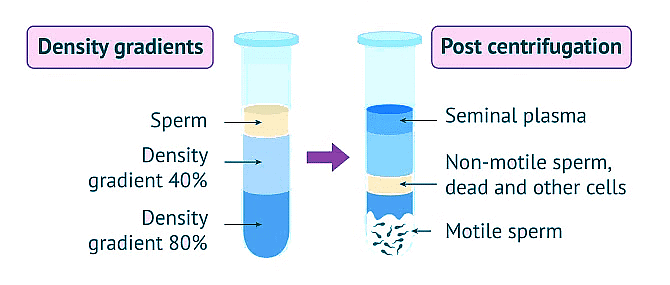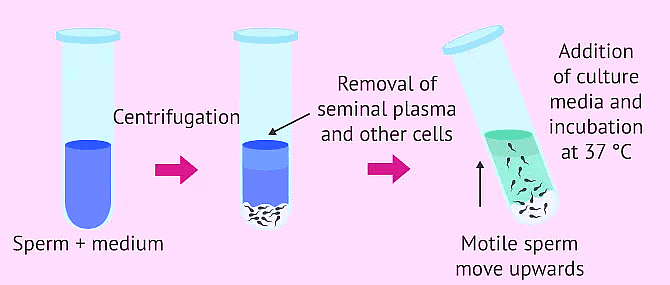Sperm Cell Capacitation | Zoology Optional Notes for UPSC PDF Download
Capacitation of spermatozoa in vivo
When the sperm come into contact with the female reproductive system, they reach their final stage of development in which they acquire the ability to fertilize.
As they advance towards the Fallopian tubes, where they will find the egg cell, a series of transformations occur in a process that we call sperm capacitation.
Two major changes occur:
- On the one hand, sperm acquire the capacity of performing the acrosome reaction, which will allow them to penetrate the zona pellucida (ZP) of the egg cell. The acrosome reaction enables the release of enzymes from the acrosome (a structure of the sperm cell), which are needed to penetrate the ZP.
- On the other hand, they also experience changes in the way they move, from a straight movement into an oscillating one, characterized by powerful impulses of the head. This process is known as sperm hyperactivation.

Once the spermatozoa are released in the ejaculate, the capacitation process does not happen at same time in all of them. As such, when they reach the egg cell, not all of them will have completed the process. Thus, those that are already capacitated at this point will have a higher chance of being the final winner of this race to fertilize the egg.
Capacitation of spermatozoa in vitro
- In a fertility treatment like Intrauterine Insemination (IUI), sperm do not go through the female reproductive system as they would in natural fertilization. Instead, they are directly placed inside the uterine fundus. For this reason, the molecular transformation that occur in vivo must be imitated to give the sperm the ability to fertilize the egg.
- The same is true for in IVF cycles, whether they are done following the conventional process or using ICSI (Intracytoplasmic Sperm Injection). The sperm must go through the capacitation process outside the female body, as the egg-sperm fusion occurs in the laboratory.
- Both procedures require pre-treatment of the ejaculated sperm in the laboratory that is known as in vitro sperm capacitation.
When done in vitro, the capacitation process can be performed using one of the following methods:
- Density gradient centrifugation
- Sperm washing by swim-up
Thanks to these techniques, sperm are separated from the seminal fluid and are classified based on their motility and morphology. In this way, we can obtain a sperm sample with a higher concentration of sperm capable of fertilization.
Density gradient centrifugation
Two or three culture media of different densities are used in an attempt to simulate each one of the phases the sperm go through naturally within the female reproductive system.

Media are placed in a test tube from higher to lower density, followed by the semen sample. After centrifuging the tube, sperm with the best qualities will have been able to overcome all the gradients and reach the bottom of the tube. This is the fraction that we separate and extract to perform the fertility treatment, as they are the sperm with progressive motility.
Sperm washing by swim-up
This is the traditional method we use for sperm capacitation in vitro. It consists of selecting the best spermatozoa based on their ability to move upwards in a particular culture media.
The sperm sample is centrifuged to gather all the cells at the bottom of the tube and remove the seminal plasma. Then, a specific culture media is added and the tube is left in an inclined position, so that the best quality sperm can swim upwards until they reach the edge.
After approximately 45 minutes, the upper part of the culture media is separated, which will contain sperm with progressive motility that will be later used for artificial insemination or IVF.

Motile Sperm Count (MSC)
After capacitation, a drop is removed from the sample, to evaluate the quality of the sample before using it in a reproductive cycle.
The result of this analysis is given as the number of motile sperm with straight trajectories per milliliter of ejaculated sperm. It is known as Motile Sperm Count (MSC).

Indeed, sperm capacitation techniques are useful for two purposes: firstly, they allow us to find out the quality of the sperm sample before performing an IUI or IVF cycle. Secondly, because it also acts as a diagnostic test for male infertility.
In this sense, this process becomes what is known as MSC semen analysis or MSCN sperm capacitation test. It involves a basic semen analysis followed by capacitating the sample in order to determine, based on sperm quality, which reproductive technology to use.
Even though the following are orientative guidelines, sperm capacitation results are usually associated with assisted reproduction techniques in the following ways:
- MSC above 3 million motile sperm per ml of semen: IUI is the technique of choice.
- MSC between 1 and 3 million motile sperm per ml of semen: Classical IVF is chosen.
- MSC below 1 million motile sperm per ml of semen: ICSI is the recommended technique.
What is sperm capacitation used for?
- In accordance with embryologist Luis Gijón Tévar, sperm capacitation involves the preparation of a sperm sample in order for it to acquire its fertilization ability.
- Sperm capacitation is used whenever we are conducting a fertility procedure. In principle, in order to carry out an IUI, IVF or ICSI process, the sperm sample needs to be prepared. Moreover, the sample should contain only motile and viable sperm in order for a pregnancy to occur.
- This is achieved using reproductive technologies, thereby causing the live, motile and best sperm to fertilize the egg cell, either in a more natural way as in the case of insemination, or in the petri dish when used for IVF.
- So, in short, the ultimate goal of sperm capacitation is, firstly, to select only live spermatozoa, with the ability to move forward; secondly, to prepare the sperm in order for them to have a fertilizing ability towards the egg cell, so that they can result in a viable embryo.
|
198 videos|351 docs
|
FAQs on Sperm Cell Capacitation - Zoology Optional Notes for UPSC
| 1. What is density gradient centrifugation? |  |
| 2. How does sperm washing by swim-up work? |  |
| 3. What is apoptosis? |  |
| 4. How does apoptosis occur in the context of UPSC? |  |
| 5. How can density gradient centrifugation and sperm washing by swim-up be used in assisted reproductive technology (ART)? |  |
















